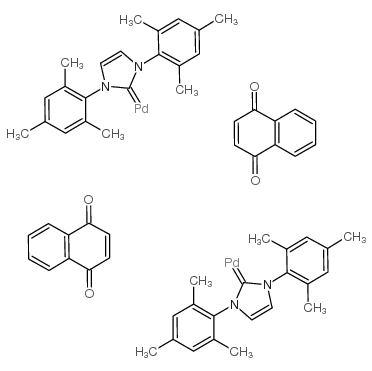1,3-Bis(2,4,6-trimethylphenyl)imidazol-2-ylidene(1,4-naphthoquinone)palladium (0) dimer
Modify Date: 2025-08-25 16:29:55

1,3-Bis(2,4,6-trimethylphenyl)imidazol-2-ylidene(1,4-naphthoquinone)palladium (0) dimer structure
|
Common Name | 1,3-Bis(2,4,6-trimethylphenyl)imidazol-2-ylidene(1,4-naphthoquinone)palladium (0) dimer | ||
|---|---|---|---|---|
| CAS Number | 467220-49-1 | Molecular Weight | 1138.00000 | |
| Density | N/A | Boiling Point | N/A | |
| Molecular Formula | C62H60N4O4Pd2 | Melting Point | >300ºC | |
| MSDS | Chinese USA | Flash Point | N/A | |
| Symbol |

GHS07 |
Signal Word | Warning | |
| Name | [1,3-bis(2,4,6-trimethylphenyl)imidazol-2-ylidene]palladium,naphthalene-1,4-dione |
|---|---|
| Synonym | More Synonyms |
| Melting Point | >300ºC |
|---|---|
| Molecular Formula | C62H60N4O4Pd2 |
| Molecular Weight | 1138.00000 |
| Exact Mass | 1136.27000 |
| PSA | 88.00000 |
| LogP | 13.64300 |
| Appearance of Characters | Powder | orange-red |
| InChIKey | ZTBFODSKEBBIJJ-UHFFFAOYSA-N |
| SMILES | Cc1cc(C)c(-n2ccn(-c3c(C)cc(C)cc3C)c2=[Pd])c(C)c1.Cc1cc(C)c(-n2ccn(-c3c(C)cc(C)cc3C)c2=[Pd])c(C)c1.O=C1C=CC(=O)c2ccccc21.O=C1C=CC(=O)c2ccccc21 |
|
Section 1: Product Identification Chemical Name:1,3-Bis(2,4,6-trimethylphenyl)imidazol-2-ylidene(1,4-naphthoquinone)palladium(0) dimer, 96% CAS Registry Number:467220-49-1 Formula:[(C21H24N2)(C10H6O2)Pd]2 EINECS Number:none Chemical Family:organometallic complex Synonym:none
Section 2: Composition and Information on Ingredients IngredientCAS NumberPercentACGIH (TWA)OSHA (PEL) Title compound467220-49-1100%no datano data Section 3: Hazards Identification Emergency Overview:Irritating to skin, eyes and respiratory tract. May be harmful if swallowed. Primary Routes of Exposure:Inhalation, skin, eyes Eye Contact:Causes slight to mild irritation of the eyes. Skin Contact:Causes slight to mild irritation of the skin. Inhalation:Irritating to the nose, mucous membranes and respiratory tract. Ingestion:No specific information is available on the physiological effects of ingestion. May be harmful if swallowed. Acute Health Affects:Irritating to skin, eyes and respiratory tract. Chronic Health Affects:No information on long-term chronic effects. NTP:No IARC:No OSHA:No SECTION 4: First Aid Measures Immediately flush the eyes with copious amounts of water for at least 10-15 minutes. A victim may need Eye Exposure: assistance in keeping their eye lids open. Get immediate medical attention. Wash the affected area with water. Remove contaminated clothes if necessary. Seek medical assistance if Skin Exposure: irritation persists. Remove the victim to fresh air. Closely monitor the victim for signs of respiratory problems, such as difficulty Inhalation: in breathing, coughing, wheezing, or pain. In such cases seek immediate medical assistance. Seek medical attention immediately. Keep the victim calm. Give the victim water (only if conscious). Induce Ingestion: vomiting only if directed by medical personnel. SECTION 5: Fire Fighting Measures Flash Point:none Autoignition Temperature:none Explosion Limits:none Extinguishing Medium:carbon dioxide, dry powder or foam. Fire fighters should be equipped with a NIOSH approved positive pressure self-contained breathing apparatus Special Fire Fighting Procedures: and full protective clothing. Hazardous Combustion andIf involved in a fire this material may emit irritating fumes. Decomposion Products: Unusual Fire or Explosion Hazards: No unusual fire or explosion hazard. SECTION 6: Accidental Release Measures Small spills can be mixed with vermiculite, sodium carbonate or other suitable non combustible adsorbent and Spill and Leak Procedures: swept up. SECTION 7: Handling and Storage Handling and Storage:Store cold. Handle and store under an inert atmosphere of nitrogen or argon. SECTION 8: Exposure Controls and Personal Protection Eye Protection:Always wear approved safety glasses when handling a chemical substance in the laboratory. Skin Protection:Wear protective clothing and gloves. Ventilation:Handle the material in an efficient fume hood. If ventilation is not available a respirator should be worn. The use of respirators requires a Respirator Respirator: Protection Program to be in compliance with 29 CFR 1910.134. Ventilation:Handle the material in an efficient fume hood. Additional Protection:No additional protection required. SECTION 9: Physical and Chemical Properties Color and Form:orange-red powder Molecular Weight:1138 Melting Point:no data Boiling Point:no data Vapor Pressure:no data Specific Gravity:no data Odor:none Solubility in Water:insoluble SECTION 10: Stability and Reactivity Stability:air sensitive Hazardous Polymerization:no hazardous polymerization Conditions to Avoid:prolonged contact with air Incompatibility:strong oxidizing agents Decomposition Products:carbon dioxide, carbon monoxide, nitrogen oxides, palladium oxides and organic fumes. SECTION 11: Toxicological Information RTECS Data:No information available in the RTECS files. Carcinogenic Effects:no data Mutagenic Effects:no data Tetratogenic Effects:no data SECTION 12: Ecological Information Ecological Information:No information available SECTION 13: Disposal Considerations Disposal:Dispose of according to federal, state, and local regulations. SECTION 14: Transportation Shipping Name (CFR):Non-hazardous Hazard Class (CFR):NA Additional Hazard Class (CFR):NA Packaging Group (CFR):NA UN ID Number (CFR):NA Shipping Name (IATA):Non-hazardous Hazard Class (IATA):NA Additional Hazard Class (IATA):NA Packaging Group (IATA):NA UN ID Number (IATA):NA SECTION 15: Regulatory Information TSCA:Not listed in the TSCA inventory SARA (Title 313):Title compound not listed Second Ingredient:none SECTION 16 - ADDITIONAL INFORMATION N/A |
| Symbol |

GHS07 |
|---|---|
| Signal Word | Warning |
| Hazard Statements | H315-H317-H319-H335 |
| Precautionary Statements | P261-P280-P305 + P351 + P338 |
| Personal Protective Equipment | dust mask type N95 (US);Eyeshields;Faceshields;Gloves |
| Hazard Codes | Xi |
| Risk Phrases | 36/37/38-43 |
| Safety Phrases | 26-36/37 |
| RIDADR | NONH for all modes of transport |
| WGK Germany | 3 |
| HS Code | 28439000 |
| MFCD06656102 |